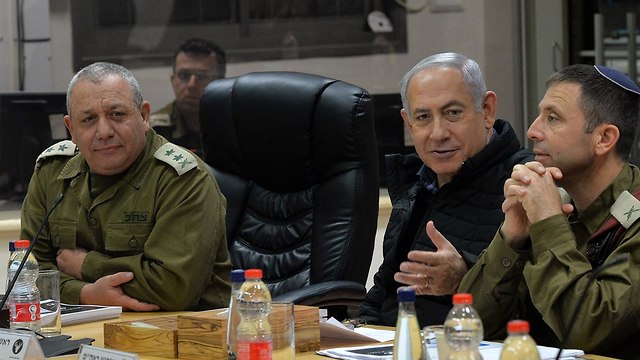Opinion: The departing IDF chief of staff has experienced victories and defeats over the past four years; will his successes in the Palestinian arena and most recently against Iran in Syria earn him a place among the greats?
The past weekend, which he spent in the IDF’s subterranean Command and Control Center at the Kirya base in Tel Aviv, sums up IDF Chief of Staff Gadi Eisenkot’s tenure well: Friday saw violent rioting on the Gaza border, and on Saturday night a rocket was fired from the Gaza Strip. At the same time, a stabbing attack in Kiryat Arba was thwarted by troops and a civilian, and several hours later Syrian state media reported an IAF strike against an arms shipment coming from Iran. This was the state of the three significant fronts the IDF chief, who retires on Tuesday, has had to deal with—and this without taking into account the civilian and political fronts he had to contend with.
On the backdrop of this, there’s the fierce hatred towards him on social media and in the comment sections of news websites, the likes of which no IDF chief before him has seen. It originates in two incidents that happened during his tenure: the first is the Elor Azaria affair, and his choice to stick to his values, which polls show was not a popular choice; the second is his handling of Gaza terrorism over the past eight months. It’s true that Eisenkot’s tenure was far from perfect, but the hatred directed as someone who has served the state for 40 years should concern us all. He doesn’t deserve this, and neither do we.

A true evaluation of an IDF chief’s tenure can only be done years after the dust settles, but initial conclusions can be drawn. On the northern front, in the fight against Iranian military entrenchment, the outgoing IDF chief has completed his mission. His predecessor Benny Gantz began this war-between-wars, and Eisenkot took it to the next level, achieving great results thanks to accurate intelligence and an excellent Air Force—two branches of the IDF that are far superior to its infantry.
This success is likely what made Eisenkot in recent days to lift the veil of ambiguity surrounding Israel’s attacks in foreign countries, an ambiguity the IDF has been zealously maintaining during his years at its helm. In interviews published in the foreign media over the weekend, Eisenkot boasted of attacks on “thousands of targets without claiming responsibility”—comments the likes of which he hasn’t made before.
In the West Bank, he dealt correctly with the wave of terrorism and led a policy—which has proven itself—to differentiate between the Palestinian population and the terrorists, despite pressure from ministers to impose collective punishment on the Palestinians.
In the Gaza Strip, he could take credit for accelerating the construction of the underground obstacle on the border as well as the border fence, and mostly for thwarting the Hamas tunnel threat, making it near irrelevant compared to what the terror group had planned for its next conflict with Israel.

And a lot has already been written about his multi-annual “Gideon” plan that allowed the IDF to develop long-term stability.
But not all was great during his tenure, and that too should be noted. He inherited a greatly deterred Gaza, but his replacement Aviv Kochavi will have to contend with the significant erosion of that deterrence. In addition, the IDF’s performance and results in recent rounds of fighting against the strip have not been good: over the past eight month, Hamas launched over 1,000 rockets at Israel, an unquestionably high number. Then there’s the incendiary balloon and kite terrorism, which Eisenkot erroneously underestimated. In fact, Hamas leader in Gaza Yahya Sinwar is the one who decides what life would look like for Israeli communities on the Gaza border, not the State of Israel.
In the past year alone, there has been a series of severe incidents in elite units, which exposed a problematic culture: playing with guns at the Duvdevan Unit, which claimed the life of IDF soldier Shachar Strug; hazing at the Maglan Unit, which was exposed after the unnecessary serious injury of soldier Eli Hayut; and last week an unnecessary death of IDF soldier Evyatar Yosefi in the Paratroopers’ reconnaissance battalion, after commanders decided to hold a solo navigation exercise on a stormy winter day.
There were also mishaps: The poor operational conduct of the forces of the Netzah Yehuda Battalion in the Ramallah area; a Hamas anti-tank missile hit a bus that had been carrying soldiers along the Gaza border, which only miraculously did not lead to a major disaster; and the failure of the classified operation in Khan Yunis in November that led to the death of an officer.

But the main problem during Eisenkot’s term – which is unrelated to the operational sphere, but no less important – is the issue of motivation. The motivation to serve in combat units reached an unprecedented low during his tenure. Even the motivation for enlisted service is constantly in decline; it might be harder to measure, but senior officers in the General Staff are quite vocal about the fact that the new model for service has been catastrophic in terms of the quality of personnel remaining in the army, and it will be many years before this can be rectified. And we haven’t even touched on the damning June 2018 report by the IDF ombudsman, who harshly criticized the military’s readiness.
Eisenkot’s inner circle is touting the fact that Israel did not go to war during his tenure an achievement. But the main task of the chief of staff is not to prevent war, but to win a them and to prepare the army properly for the next one.
As reported by Ynetnews
